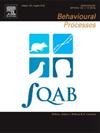Impact of tourism on bird behavior: A comparison of flight initiation distance between birds in areas of tourist and non-tourist attraction
IF 1.3
4区 生物学
Q4 BEHAVIORAL SCIENCES
引用次数: 0
Abstract
Tourism, as an important manifestation of urbanization, is becoming increasingly popular. Although it offers numerous advantages for the local community, it also exerts a multifaceted impact on local wildlife. Previous research on the effects of tourism has mainly focused on protected areas or tourist spots, rarely considering the surrounding non-tourist attraction areas. Therefore, exploring the behavioral differences of wildlife in response to different levels of human disturbance in areas of tourist and non-tourist attraction will contribute to a more comprehensive understanding of the impact of tourism activities on animals. This study compared the differences in the flight initiation distance (FID) of Eurasian tree sparrows (Passer montanus) between areas of tourist attraction (Xijiang Miao Village and Zhaoxing Dong Village) and non-tourist attraction (surrounding villages) in Guizhou Province, southwestern China. We found that Eurasian tree sparrows in areas of tourist attraction exhibited shorter FIDs than those in areas of non-tourist attraction, suggesting that Eurasian tree sparrows inhabiting areas with higher levels of human disturbance demonstrate a greater ability to adapt to anthropogenic disturbance. Moreover, the FID of Eurasian tree sparrows was less influenced by flock size than by tourist attraction category. It highlights the notable impact of human activities on wildlife, contributing to the scientific management and protection of birds in urban environments.
旅游对鸟类行为的影响:旅游景区与非旅游景区鸟类起飞距离的比较
旅游业作为城市化的重要表现形式,越来越受到人们的欢迎。虽然它为当地社区提供了许多好处,但它也对当地野生动物产生了多方面的影响。以往关于旅游效应的研究主要集中在保护区或旅游景点,很少考虑周边的非旅游吸引区。因此,探讨旅游景区和非旅游景区野生动物在不同程度人为干扰下的行为差异,将有助于更全面地了解旅游活动对动物的影响。本研究比较了贵州省旅游景区(西江庙村和肇星洞村)与非旅游景区(周边村庄)间欧亚树麻雀(Passer montanus)的飞起距离(FID)差异。研究发现,生活在旅游景区的欧亚树雀比生活在非旅游景区的欧亚树雀表现出更短的FIDs,表明生活在人为干扰程度较高地区的欧亚树雀对人为干扰的适应能力更强。此外,欧亚树雀的FID受种群规模的影响较小,而受旅游景点类别的影响较小。它突出了人类活动对野生动物的显著影响,有助于科学管理和保护城市环境中的鸟类。
本文章由计算机程序翻译,如有差异,请以英文原文为准。
求助全文
约1分钟内获得全文
求助全文
来源期刊

Behavioural Processes
生物-动物学
CiteScore
2.70
自引率
7.70%
发文量
144
审稿时长
4-8 weeks
期刊介绍:
Behavioural Processes is dedicated to the publication of high-quality original research on animal behaviour from any theoretical perspective. It welcomes contributions that consider animal behaviour from behavioural analytic, cognitive, ethological, ecological and evolutionary points of view. This list is not intended to be exhaustive, and papers that integrate theory and methodology across disciplines are particularly welcome.
 求助内容:
求助内容: 应助结果提醒方式:
应助结果提醒方式:


